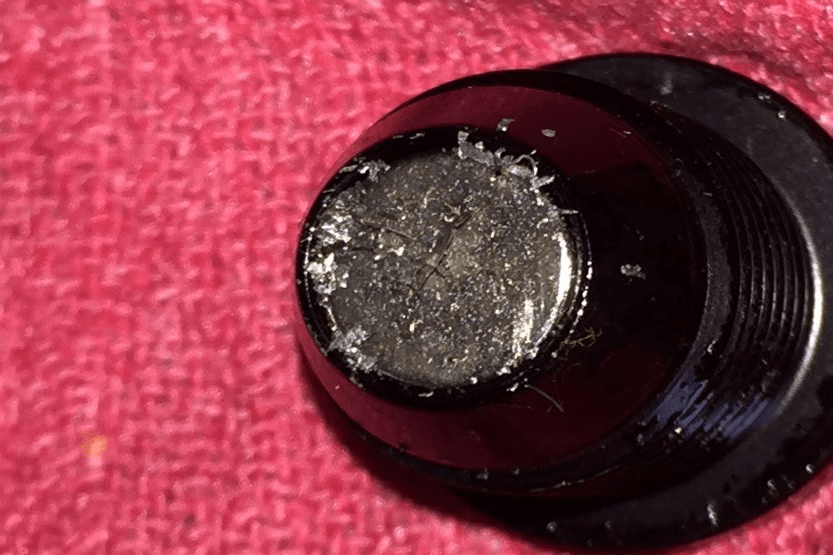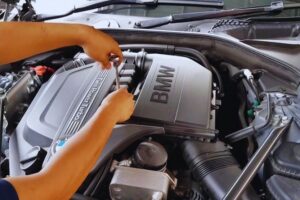Metal shavings in oil can damage your vehicle’s engine, so it should be looked at and fixed as soon as possible. What does it mean to have metal shavings in oil, and what should you do?
Fine metal shavings in your car’s oil are caused by friction of the engine’s components. The engine’s components are rubbing against each other and creating this debris. This friction is due to a lack of oil and lubrication.
Also known as chips or filings, these shavings can build up if you don’t regularly change or maintain your vehicle’s oil. The metal shavings increase the risk of your engine’s wear and tear, shortening your car’s lifespan.
These fine metal shavings that have built up could cause your engine’s deterioration. This is because the metal shavings present in the oil would prevent the oil’s smooth flow to the engine’s parts. This process will cause the engine’s parts to malfunction.
To fix this issue, you should bring your car to a mechanic to inspect the engine and do an oil change. To prevent this issue from happening, follow these tips:
- Monitor and Maintain Motor Oil Properly
- Choose Compatible Oil
- Change the Oil Before Metal Shavings In Oil Pan Accumulate
- Follow the Vehicle’s Servicing Schedule
Read on to learn more about metal shavings in oil and how you can fix this issue.

Metal Shavings in Oil
Metal shavings in oil are caused by friction of the engine’s components. The engine’s components are rubbing against each other and creating these shavings. The friction is due to a lack of oil and lubrication.
When you don’t change the engine’s oil regularly, the oil will not flow smoothly into its parts. This occurrence will cause inadequately oiled parts, such as bearings and bushings, to grind against each other. The friction of these grinding movements will produce metal shavings.
The metal shavings go into the oil, causing further engine damage as the shavings build up. The accumulated shavings further increase the deterioration of your vehicle’s engine or transmission. The rotating parts will grind against the shavings because of inadequate lubrication or oil flow, increasing the risk of wear and tear.
How Often Should You Change Oil?
For new vehicles, you have to change the oil more often. First, use break-in oil to break-in your vehicle. You can then change your oil after 50 miles (80.467 km), 500 miles (804.67), 1,500 miles (2414.02 km), 2,000 miles (3218.69 km), 4,000 miles (6437.38 km), and so forth.
Remember to change your oil filter, too, to ensure that your oil is filtered of impurities, debris, and shavings.
Symptoms of Metal Shavings in the Engine’s Oil
1. Reduced Power
You will experience reduced engine power when there are accumulated metal shavings in your oil. The shavings can clog your engine, preventing it from functioning. The worst thing is when your engine suddenly stops in the middle of the road. So it is very important to ensure there are no metal shavings in the oil.
2. Engine Knocking
There is a correlation between fine metal shavings in oil and knocking sounds. You will hear a loud knocking sound from your engine when there are metal shavings in your oil. This loud knock is caused by the engine’s parts knocking against each other because they lack lubrication. These knocking sounds will increases as you speed up your engine.
3. Oil Pressure Drops
The oil pressure drops when the main bearings fail to function adequately. So, when you notice this happening, check your main bearings immediately before a serious accident occurs.
4. Ticking Noises
Ticking noises indicate that the engine oil is not flowing properly into the engine’s components. The oil could not flow smoothly when your engine’s oil is full of debris or metal shavings. Thus, the engine will produce a ticking sound.
5. Vibration When Idling
Unnecessary friction between the engine’s parts because of inadequate lubrication will cause your vehicle to vibrate or shake when idle. In these instances, you have to check your engine oil. It may be below the required oil level, or it might be because the oil is dirty and contains metal shavings.
Metal Shavings in Oil Pan – What Does It Mean?
What do metal shavings in oil mean? One of the best ways to determine the engine failure is to identify the type of metal shavings or flakes and to determine why they exist.

1. Bronze, Copper, or Brass Shavings
If the shavings are brass, bronze, and copper, the engine components involved are worn-out bushing or bearings. The camshaft bearings, crankshaft, wrist pin bearings, or turbo thrust bearings will contaminate your oil with copper-colored dust particles, shavings, or debris.
Worn rod bearings will leave copper-colored steel shavings. Copper is usually contained in the third lead layer of rod bearings. The first layer is steel, and the second is aluminum. When damage to the rod bearing is severe, this occurrence will leave large copper or steel shavings in your oil.
2. Molybdenum and Chromium Shavings
The accumulation of molybdenum and chromium shavings in your oil indicates the piston or piston rings’ breakage.
3. Aluminum Shavings
Aluminum shavings in your vehicle’s oil can come from wear on the camshaft’s aluminum caps or the overhead camshaft’s bearing.
4. Iron Shavings
You can identify the shavings in your oil as iron by using a magnet. If the magnet draws the particles, then the shavings are iron. Iron shavings denote that the malfunction comes from the valve train parts, the camshaft, and the crankshaft. These are the rotating components of your engine.
A dysfunction in your turbocharger could also produce metal shavings in oil. You can buy a kit from auto stores to analyze the metals present in your oil. You can send it out to a reliable oil store to determine the type of shavings present in your oil as well.
This method is useful when you do not notice any symptoms. Don’t wait until you observe the symptoms. You have to do preventive maintenance to cut your repair cost.
We have discussed the causes, symptoms, and how to identify the fine metal shavings in the oil. Let’s now proceed in learning how to prevent the build-up of metal shavings in your engine.
How to Prevent Formation of Metal Shavings in Oil Filter or Pan?
To fix the issue of having metal shavings in your oil, you should bring your car to a mechanic to inspect the engine and do an oil change.
To prevent this issue from happening, follow these tips:
- Monitor and Maintain Motor Oil Properly
- Choose Compatible Oil
- Change the Oil Before Metal Shavings In Oil Pan Accumulate
- Follow the Vehicle’s Servicing Schedule
1. Monitor and Maintain Motor Oil Properly
It is good practice that you check your oil every time you fill up your gas. Your car’s manual may not say so, but if you’re driving a lot, especially within your city, you have to check often.
Visually check your oil regularly by locating the dipstick under the hood and observing its appearance. The oil must be transparent and brown to amber in color and reach at least half of the dipstick.
You can do this twice to ensure that you have clean oil without metal shavings. If the oil appears dark, grimy, with metal shavings and does not fill half of the dipstick, it’s time to change it.
You have to change your motor oil regularly and monitor its cleanliness. Check it often for visible metal shavings and schedule it for servicing as your mechanic recommends. The schedule would depend on the type of vehicle you have. Brand new cars would differ from used vehicles when it comes to maintenance.
2. Choose Compatible Oil
Choosing the right oil is very important to prevent metal shavings. When you have chosen the correct oil for your vehicle, the risk of wear is significantly decreased. Naturally, you should use the right type of gas. If you do, you’re lengthening the life span of your vehicle. You are also preventing the formation of harmful metal shavings in your engine’s oil.
So ensure that you choose the right grade and oil for your engine. Changing your oil to something not compatible would damage your engine more than the metal shavings.
You can choose from the three types of engine oils: synthetic blend, mineral oil, or full synthetic oil. Your vehicle’s manual will guide you on what oil is best for your engine.
Use only high-quality brand oils explicitly recommended for your car. It may be more expensive at the onset, but you could save hundreds of dollars on repair later.
It would help if you also chose the appropriate grade of oil for your engine. The grade indicates the oil’s viscosity (thickness) and whether the oil is for hot or cold climates. Selecting the proper blend for your car would prolong its life.
3. Change the Oil Before Metal Shavings in Oil Pan Accumulate
Change your motor oil often. One way to prevent the accumulation of metal shavings is to change your oil frequently. You don’t have to wait for the collection of metal shavings before changing your oil. Remember not to fill up your engine with too much oil, which can also damage your engine.
Most experts recommend changing it according to how often you use your vehicle. If it’s normal usage, you can follow the instructions in your manual.
Nevertheless, if you push your engine harder than usual, you must change your oil earlier than what the car’s manual provides. Usually, you should change the oil after three months or 3,000 miles to 5,000 miles.
4. Follow the Vehicle’s Servicing Schedule
Even if nothing is wrong with your vehicle, follow its servicing schedule religiously. Treat your car as a person that needs to have a general check-up for at least six months to one year. As the cliché goes, “Prevention is better than cure.”
Don’t wait until your car is so ‘sick,’ it would be too late to repair it. When you observe a minor problem, deal with it immediately to prevent further damage. The repair cost would bore a hole in your pocket when that minor problem would turn into a major one.
If you follow the recommended service schedule, a professional can inspect the engine and whole car on a regular basis to ensure it is running smoothly.
Functions of Motor Oil
Motor oil has crucial functions in minimizing damage to your car and in lubricating the vital parts of your car’s engine so that they could function well.
1. Reduces Friction
The oil reduces friction, preventing internal engine damage.
2. Cleans Engine
The oil also cleans your engine by collecting metal shavings, debris, and sediments. When you change your motor oil, these unwanted, harmful materials are discarded as well.

3. Prevents Corrosion
Motor oil will protect the complex engine parts from corrosion. Make sure to consult your mechanic on what oil is best for your engine to prevent corrosion. Synthetic oils are better than traditional oils. Take note to choose the best grade oil for your engine too.
4. Regulates Temperature
Motor oil could also prevent overheating by absorbing the heat from different engine parts. Overheating can cause severe damage to vital parts under the vehicle’s hood. The oil will absorb the heat as it passes from one part of the engine to another.
Cost for an Oil Change
The cost would depend on your area. An oil and filter change usually costs between $45 and $75. In case you want synthetic oil, the price is higher, between $85 and $150.
It is not that expensive compared to a repair cost that you will shoulder when you don’t regularly change your oil.
You could also do it yourself, provided that you have sufficient knowledge of automotive parts. However, since the service is affordable, you can drive your car and let expert car mechanics change your oil. In case you insist on doing it yourself, you can expect a $15 to $20 discount.
Conclusion – Fine Metal Shavings in Oil Pan or Filter
What do metal shavings in oil mean? What do metal shavings in oil and knocking mean? The friction of the engine’s components’ causes metal shavings in oil due to lack of oil and lubrication.
As the shavings or debris accumulate, the oil finds it hard to flow smoothly into the engine’s components. So, they further rub against each other, adding to the shavings already present in the oil.
Also known as chips or filings, these shavings could build up if you don’t change your vehicle’s engine oil regularly. The build-up of these shavings could make a knocking or rattling sound.
These metal shavings increase the risk of your engine’s wear and tear, shortening the life span of your engine. So, if you want your vehicle to last as long as you do, you have to maintain and monitor your engine’s oil properly.
Related reading:
Oil Filter Brands to Avoid [5 Wost Oil Filter Brands]

![Read more about the article Pennzoil Ultra Platinum 5w30 Oil [Full Review]](https://roadsumo.com/wp-content/uploads/2022/02/Pennzoil-ultra-platinum-5w30-oil-300x200.jpg)

